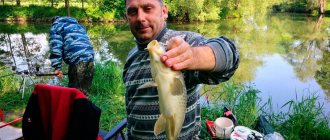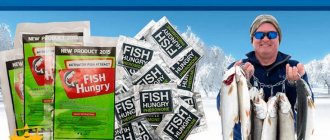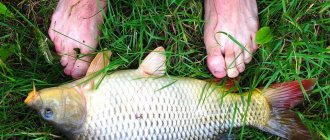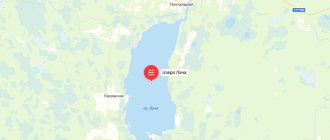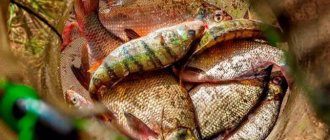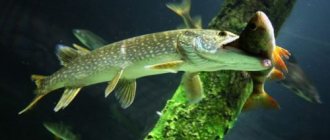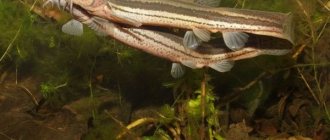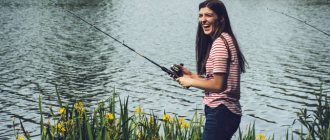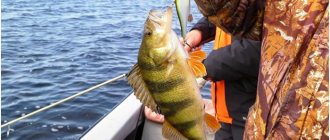Fishing in April - where to look for fish?!
Most fish species become noticeably active in April. The fishermen's catch may include crucian carp, bream, silver bream, perch, and white bream, but most of the fishing in April involves fishing for roach, which is caught both on a float and on a feeder or donkey. Among the predators there are perch, pike and pike perch, asp, but hunting for catfish will have to wait a couple of months, since the April water is still cold for it.
First of all, you should look for fish in April in places with slow currents and the presence of natural food, such as:
- edges of underwater vegetation;
- mouths of tributaries;
- bays;
- bushes and flooded trees in the water;
- underwater holes or, on the contrary, mounds;
- at the border of the current and the coastal calm.
During high water, fish should be looked for in the area of flooded shores, since there is less turbidity in the water, which allows the fish to swim into such places and rinse their clogged gills.
If it’s a warm and sunny day, then you should think about catching April bream, which often comes to the shore in good weather and is caught at a depth of half a meter to one and a half meters. At the same time, you should not forget about the bottom of the reservoir - bream loves a muddy or clay-sandy bottom.
Such interesting small rivers. We are looking for fish in April. Secrets and secrets of success
Early spring fishing very often raises a lot of questions from anglers. And if on lakes the behavior of fish can be at least somehow predicted due to a certain stability of the water level and the direct dependence of the choice of habitat on its temperature, then on rivers everything is much more complicated and confusing. It would seem that it could be simpler - to wait for the coveted warmth and rush to your well-known site, where, apparently, large ides and chubs have been waiting. However, the situation changes at the very last moment, and the fisherman who arrives at the river is left with nothing.
And half a kilometer from the cherished “point”, where there were never fish in the spring, plump roach and dace are caught. This kind of unpredictability complicates early spring river fishing - the fish may be active, but it will feed completely differently from where the fisherman is looking for it. It is for this reason that some fishermen have a feeling of complete lack of bite, and, at the same time, the most memorable fishing trips of their lives for others. Moreover, it comes to the paradoxical point - from complete “doesn’t bite” to “a bite on every retrieve” the fisherman can be separated by some 200-300 meters of the river.
What does bite depend on?
There are a huge number of factors that directly affect the bite in early spring. There are much more of them than in the summer low water, and therefore it is unlikely to be possible to attribute everything to a banal drop in pressure or the phase of the moon.
You should start with the most banal things - the water level, the degree of its illumination, as well as the dynamics of its change. A sudden melting of spring snow, accompanied by fog and rain, almost always means the end not only of biting, but also of fishing in general. The water instantly becomes cloudy, its level rises, and the amount of debris carried by the stream increases many times over. Almost always in such a situation, the fish “crowd” into secluded corners and stops feeding.
Clean, shallow rivers, which almost all watercourses have become in recent years, present no less difficulty to the fisherman. Due to abnormally warm winters, flooding as such is not observed, and the water level in the rivers is almost identical to the summer level. Many fishermen initially rubbed their hands enthusiastically - this is happiness! There is no flood, which means you can start fishing in February. However, their joy was premature - not only were the fish’s migrations in low water much smaller in number, but they also stayed away from the shore, frightened by every noise. In such a situation, a feeder could help out, but only the minimum depth and increased current, as well as a large amount of debris, do not allow full fishing and feeding the fishing point.
The second thing that should be highlighted is the temperature of the air and, as a result, the water. It is not entirely correct to consider the dependence of this factor in an independent manner: it is much more reasonable to link it with the water level. The best weather for fishing is considered to be “mild” weather, when daytime warmth alternates with night frosts. In such a situation, the water level does not rise too sharply, and the muddy water brightens quite a lot overnight. Such weather allows you to “hold back” the flood and prevent excessive river flooding.
Temperature changes also make their contribution, which can also “kill” the fish. Unlike the summer period, when a slight cold snap only activates the bite and makes the fish active, the return of winter in March almost always promises snowstorms, strong winds and a drop in daytime temperatures below zero. Of course, there is nothing good about this - the fish stop feeding, and Fishing in such conditions is a dubious pleasure.
The weather can also make adjustments to the development of the situation. It has been repeatedly noted that a change in weather even during one fishing trip can dramatically affect the fish bite. Early spring weather is almost always cloudy, and in this regard, even a short-term appearance of the sun (unless, of course, fishing takes place in shallow, clear water) quite often activates the bite. Sometimes the angler may get the impression that there are no fish at the fishing point, as evidenced by the complete absence of bites, but as soon as the weather clears up, out of nowhere the fish appears at the fishing point and begins to feed.
The correct choice of bait for fishing in March is also of great importance. Right now, fish can be extremely selective and react exclusively to any particular bait or attachment. Sometimes the lack of bites may not be the result of bad weather or the “wrong” water level. It happens that a fisherman deliberately chooses the wrong bait, guided by some principles known only to him, thereby dooming himself to failure. Much more revealing can be a “duel” between two fishermen, one of whom unsuccessfully “bathes the float” for several hours, and the second, not having time to reach the point, begins to catch fish one after another almost from the first cast. Such a situation may seem like a fairy tale, but it is in March that this happens all the time. In this regard, we can only advise you not to “rest” in any one bait or attachment (for example, the same bloodworm), but to stock up on as wide a variety of options as possible and if there is no bite, do not be afraid to use them. In addition to bloodworms, the fisherman’s arsenal should include a dung worm, maggot, caddis fly larva (a must!), as well as canned corn and steamed pearl barley. The last two baits “shoot” quite often - for some reason, large fish prefer vegetable baits, completely ignoring the “meat”. They can also be used as bait, throwing a couple of grains to the float before each retrieve.
What should the conditions be for successful river fishing in March? First of all, you should carefully monitor the water level and the degree of its transparency. If the level is rapidly rising or remains at its highest level, and the consistency of the water resembles coffee with milk, you should refrain from going to the river. The best time for fishing comes when the level stops rising, the river, having been at its maximum for some time, begins to fall, and water transparency gradually returns to normal. Plus 1.5-2.5 meters to the summer level, which gradually drop - the best values for successful fishing. In addition to this, they also pay attention to the weather - the temperature should be positive, the wind should be stable, and the atmospheric pressure should not jump back and forth.
Where to look for fish in March on small rivers?
Of course, this information is very conditional and quite general. The nature of watercourses can be completely different, and for fish these rivers can have completely different meanings: some can act as feeding grounds, others can be considered by fish exclusively as spawning grounds, and others can even act as wintering grounds and are abandoned when the flood begins.
Where to look for fish in March on small rivers? First of all, places that have the maximum depth for such rivers, as well as runs and spits immediately adjacent to them, will be promising for fishing. As a rule, the maximum depth on such rivers rarely exceeds 2-3 meters, and therefore you can meet fish already at a one and a half meter run. When searching for fish, you should not rely on your “summer” knowledge and experience - those places whose depth in March is 1.5-2 meters, in the summer you can go without soaking your swimming trunks. Moreover, depending on the intensity of the flood, it makes sense to consciously check small, by summer standards, places: very often this is where you can find large fish.
Very important attention should be paid to the places of flood drainage and the confluence of various streams and micro-rivulets. In spring, they can bring a lot of benefits: in addition to food carried by the current and attracting fish, they are able to create quite noticeable sand spits that cut deep into the river. Chub and dace are very fond of such places: by passing the equipment along the dump, the angler is guaranteed to get a fish bite.
All sorts of river turns can also be very good places for spring fishing. Here, as a rule, the terrain is fairly uniform: the inner bank of the turn is gentle and sandy, the outer bank is steep. It is under it that the main depth begins, which lasts until the middle of the river, after which a more or less smooth rise follows. A pronounced current is observed only from the gentle bank to the middle of the river - the return “reigns” at the cliff. You can fish in such places from both banks. If the angler is located on a flat bank, he has the opportunity to work with the gear and make a controlled retrieve along the drop, or pass the bait in an arc, starting in the hole itself and pulling it along the arc towards his shore. He can do the same thing from a steep bank, which, in some situations, is much easier to do due to the fact that the angler is much higher than the water line. In addition, there is also stationary fishing in a plumb line or on a half-bottom: it is here, under your feet, that you can “wait” for a fish to bite. In the latter case, the fishing turns out to be stationary, the angler fishes all day in one place, alternately checking both the main stream and the pool itself.
If the section of the river in the fishing zone is near the mouth - a small river flows into a larger one - it is imperative to check the confluence. Quite often, the mixing of two streams forms a fairly noticeable hole at the confluence with a reverse flow, in which someone always lives. Here you can also fish both stationary and with controlled fishing, and on both rivers.
What to catch?
In fact, anglers have little choice in the spring. Almost always this is Bolognese tackle with a set of a wide variety of floats, selected for different fishing conditions. It is also used when the need arises for fishing with a half-bottom - the float rises to the tip of the rod, a heavier olive takes the place of the compact weight, and the angler goes into “standby mode”. Rods with a length of 5-7 meters are used: the more difficult the fishing conditions and the denser the coastal thickets, the shorter the length of the rod used. And on the contrary, clean clearings free of vegetation allow you to use a fairly long rod. It’s a sin not to use such an advantage: with the help of a long tackle, controlling the wiring is much easier and more convenient. The equipment used is quite traditional and does not differ in any special delights - a Bolognese float with a carrying capacity of up to 4-5 grams (depending on the depth of fishing and the strength of the stream), a load concentrated in one olive, a 30-40 centimeter leash and a hook for a specific bait.
If there is not much grass, and the depth at the fishing spot is more than a meter, feeder gear can also be used. Sometimes it is she who allows you to feed or wait for the passage of a school of fish. Considering the fact that fish in the spring have an absolutely neutral attitude towards bait, you should not rely on its miraculous properties: it is often useful to linger in a specific place without making frequent recasts. And on the contrary, when the fishing point is unknown, sometimes classic drift fishing comes to the rescue: a light weight takes the place of the feeder, and after casting the feeder tackle is constantly in the hands of the fisherman. Carried by the current, the sinker describes a wide arc, and the hook with bait actively searches for fish. The bite is clearly visible at the tip of the rod, and also feels great in the hand and serves as a kind of signal to hook.
March is a month of contrasts. On the one hand, this is bad weather and a complete lack of bite, at first glance. But on the other hand, the catches are sometimes such that even in the summer it will not be possible to repeat them. Very little time will pass, the fish will become active and will be caught well almost everywhere, without forcing the angler to be sophisticated and look for keys and approaches to it. But that will come a little later. In the meantime, let's catch!
What to fish for in April
The first rule of successful fishing in April is to use thin gear. Even if you have to cast at a significant distance and the use of miniature components (float, weight, etc.) becomes impossible, you must at least take care of leashes with hooks, which must be of minimal thickness, otherwise you may not see a single bite all day .
In April, it is better to fish exclusively with animal bait - worms, maggots, bloodworms, caddis flies, leeches, etc. It is also recommended to use bait to which an animal component is added - chopped worms, all kinds of larvae, etc. It is not recommended to add flavorings to the bait mixture, because too strong a smell can scare away spring fish.
Standard fishing technique:
- raising or lowering the bait;
- small pulls of bait along the bottom;
- fishing with a slowly lowering bait.
Weather plays an important role in successful fishing. It is unlikely that the fish will bite in a strong gusty wind that constantly changes its direction. Or in sudden cold rain. Fishing will be most productive in sunny weather. Even if there is a light drizzle for an hour, then after it ends and the sun comes out, the fish bite will only intensify.
April asp glutton video
Spinning fishing tactics in April
When fishing on shore in April, casting over long distances is not required. Distances of 15-25 meters are sufficient. It is advisable to place the bait in the upper or middle layers of water at an angle, depending on the speed of movement. The fish will notice it faster.
It is better to catch pike and pike perch in the morning and evening. Perch and crucian carp can bite all day long. In April, fishing is most effective near the shore and in shallow waters. In places overgrown with aquatic vegetation, heavy loaded cylindrical baits that freely pass through the thickets will help you avoid snags. They need to be easily moved up and down with the tip of the spinning rod.
When fishing with a spinning rod in April, you should not stay in one place for a long time. You have to constantly move around and fish large areas. It should be remembered that fishing with spinning rods in many natural reservoirs has restrictions on the spawning period of fish. It can take place at different times, so before preparing the tackle, ask whether it is currently prohibited. Otherwise, you may encounter fishery inspectors and, instead of a solid catch, earn an impressive fine and lose your spinning rod.
Spawning in April
No matter how much fishermen would like to completely devote themselves to their favorite pastime, it is not possible to fish in all regions, despite the prohibitions. The thing is that many species of fish begin to prepare for spawning as April approaches and the water warms up. In this regard, the law banning fishing comes into force. The law is directly related to the region where the fisherman lives. As a result, before you start fishing, you must carefully study the Fishing Rules.
Typically, during the April spawning period, fishing is allowed from the shore in places where fish do not spawn. You can fish exclusively with a float rod with one hook, although in some regions it is also permissible to use a donkey. As for spinning, it is banned almost everywhere. At the same time, we should not forget that the number of hooks on the fishing line has some restrictions associated, as already mentioned, with the region of residence. Read also: Spawning bans in the Rostov region
Important! In the appendices to the Rules there are always lists of spawning places, after studying which you will know exactly where you can sit on the shore with a fishing rod, and where instead of a catch you can actually get a serious fine or even a criminal offense. However, there is always a way out - paid sites, where fishing is not limited by Rules and Prohibitions.
Tackle, bait and groundbait for fishing in April
Fishing gear in April
So, the long-awaited fishing in April is just around the corner. Therefore, it is time to discuss the issue related to the choice of the most suitable gear. Let’s immediately focus on the fact that fishing in April for different types of fish requires the angler to have different gear. For example, white bream, dace and silver bream will be caught well with a float rod and feeder. But at this time of year it is more advisable to catch pike outside its spawning grounds using live bait gear equipped with one single hook.
Many who like to sit with a fishing rod are convinced that fishing in April will not only be exciting, but also effective only when catching roach. There is probably some truth in this statement, since in the spring the roach gathers in huge schools and quickly responds to the bait offered to it. In addition to roach, it makes sense to hunt for perch. The most effective methods of fishing for perch in April are considered to be a summer nodding fishing rod with a jig and a bloodworm (such tackle is indispensable when fishing in whirlpools with a strong current), as well as a float tackle, which will have a small jig instead of a hook.
We can say with 100% certainty that fishing in April will appeal to all those who like to hunt for crucian carp and crucian carp. These two species of fish, having slept for the winter, are trying hard to gain weight before the upcoming spawning. During this period, it is almost impossible to find a free place on “carp” or “crucian carp” ponds. Fishing in April for crucian carp is carried out mainly using a frieder or a bait-and-snake donka with a feeder. As for frequent changes in depth, this does not threaten anglers, since crucian carp are caught almost at the very bottom of the reservoir. Based on this, we can assume that it is most practical to use a blind float mount, which has separate requirements. Firstly, the chosen float should be as sensitive as possible (crucian carp takes a very long time to attach itself to the bait and it bites extremely carefully). Secondly, fishing in April means having the good old goose feather float, which has become a true classic of the genre. Such a float, provided it has sufficient sensitivity, will be clearly visible at a distance of up to 20 m, and its white neutral color will not alarm or scare away fish, as well as other living creatures living somewhere nearby. As for hooks, high-quality hooks No. 3-No. 5 are best suited here. There are no special requirements for attaching the sinker. The only condition is that it should not be too noticeable.
Fishing baits in April
Starting a conversation about bait, without which fishing in April is unlikely to be crowned with proper success, I would like to once again remind you of the difference between the concepts of “bait” and “attachment”. The latter is usually understood as absolutely everything that can be put on a hook. But only those baits that are of animal origin can be classified as bait. If you are planning a fishing trip in April, then it will be more natural to choose bait, which is most often used pellets, caddis flies, corn, maggots, bloodworms and worms. Another excellent bait can be bark beetles (beetle larvae), which most anglers for some reason often forget about.
Bait for fishing in April
Everyone knows that one of the fundamental factors on which the outcome of any type of fishing directly depends is bait. Whatever gear you choose, fishing in April is impossible without appropriate bait. Of course, there is an opinion that feeding fish will certainly lead to a decrease in biting. However, if you approach this issue correctly, that is, feed rather than overfeed the fish, then it will definitely begin to bite better. Of the variety of baits presented on the shelves of our fishing stores, it is best to purchase only the most famous and time-tested ones. The ideal option is to mix the purchased bait with breadcrumbs, mixed feed or easily washed-out porridges.
For perch in April
Compared to March, perch becomes much more active in April. Anglers' catches often include good specimens weighing half a kilogram and more. But mostly these are medium or small “sailors” who greedily pounce on almost any bait of animal origin. They do not disdain maggots, worms, or bloodworms. However, real humpback whales are caught exclusively with small live bait, which can be caught not far from the shore.
You need to look for perch in small bays, among aquatic vegetation, at the edge of last year’s reeds or cattails, but most often it hangs around flooded bushes, among trees immersed in water, or near driftwood, where it gathers in small schools. This is interesting: Perch spawning
Where and how to catch pike in April
Depending on the region, pike spawning occurs in February-March, including the beginning of April (depending on the region). Naturally, during spawning you can’t count on rich catches, but before spawning or after its end, toothy fish are actively caught both with live bait and with artificial baits.
Floaters can enjoy fishing with live bait. There are no restrictions or special “troubles” required here. The tackle can be rough, thick, ugly, but most importantly - strong. The fishing line is from 0.3 mm thick, the float is large, capable of supporting the weight of a small crucian carp or roach, the hook is double or triple, a metal leash is required.
It is better to look for pike at the edge of aquatic vegetation, among flooded bushes and trees, but real trophy specimens will be located at depth, away from the shore. And here you can’t do without a spinning rod, but you can fish with it only after the ban is lifted.
Roach bite in April
Roach and April are two synonymous words for real fishermen. It is in this month that you can catch truly trophy specimens. The main thing is to choose the right place, since the roach at this time begins to actively move to the places of its future spawning ground, along the way grabbing everything that catches its eye.
From the shore, roaches are caught by wire, using bloodworms or maggots as bait. If the fishing trail runs far from the shore, then it is better to use a feeder or donka with feeders. Roach becomes most active when the water warms up to 6-8 degrees.
True, such fishing usually does not last long. As soon as a school of fish passes a certain area, the bite sharply disappears. A roach's meal can last from several hours to several days, depending on the size of the reservoir.
With a feeder for April roach
Briefly about fishing for popular fish in the month of April
Asp in mid-spring
The asp is still weak. The water has not yet warmed up enough, so its bite is sluggish and inconsistent. You should count on more or less good asp fishing in the second half of April. April fishing for asp is like a lottery, with a low probability of winning. In the fishing calendar, opposite this fish there is a yellow square, indicating “weak bite.”
April bream
Fishing in April is very exciting and rewarding if you catch white fish. In particular, bream responds well to bloodworms, maggots and red worms. In mid-April there is, one might say, a feeding frenzy for bream. On the fishing calendar opposite the bream there is a red square indicating the best bite. It is successfully caught using feeders and donks. At this time, it is important to comply with fishing standards. It is better to release some of the fish.
Perch activity in the month of April
April fishing for perch is very productive. Its activity exceeds that of March. In mid-spring you can catch hefty humpback whales weighing 500 grams and above. Perch fishing at this time is carried out with a float rod using maggots and bloodworms. Spinning anglers use all their perch baits. These are vibrating tails, twisters and small turntables. In the fishing calendar, opposite the perch, we see an average and good bite.
How to catch April pike
Pike spawning occurs in March-April. In the first weeks after spawning, the pike rests, gets sick, as they say, and does not bite. Then her post-spawning feeding begins. April pike fishing is no less productive than March, but after spawning. The best lures for pike are jigs and twisters. Shiny twisters attract pike well in muddy water. Sometimes fishermen successfully catch pike using foam fish. On the fishing calendar, the pike bite is marked as average and good.
Pike perch fishing at the equator of spring
Fishing for pike perch in April is often productive. It is mainly caught using jig baits. Twisters in bright and milky colors are trendy. They are surrounded by offset workers and Cheburashkas. Milkers can also catch pike perch if they cast their gear into the coastal zone. In the fishing calendar, opposite pike perch is “average bite.”
Features of fishing for catfish this month
Fishing in April is productive if you use the right gear. For example, fishermen catch catfish at the end of March. And they catch it successfully. Donks are mainly used. Meat or pieces of fish, or sparrows are placed on the hooks. Catfish fishing at this time is relevant only in the southern regions, where the water has warmed up to at least 12-14 degrees. In other regions, catfish are still sleeping, which is noted on the fishing calendar.
Carp in April
The same judgment applies to carp as for catfish. It only begins to bite in the southern regions. This fish shows its activity at the end of the month. They catch it using potatoes, boilies and makuha. Sometimes dough is used. Carp is a voracious fish. Therefore, he always needs a lot of bait. It is clear that in the summer there is even more of it, but you must take several kilograms of cereals and feed for it.
How to catch roach, roach and silver bream
Fishing in April cannot do without roach. Roach and April are already synonymous. This month it spawns, and very large specimens are found. When the water warms up to 6-8 degrees, active haymaking begins, as fishermen say. Roach, and roach at the end of April, are caught on the bottom without a feeder. The main thing is to get on the paths along which it passes. This period lasts 10-14 days. They are caught with bloodworms together with maggots, as well as with a red worm.
Naturally, in the calendar opposite the roach and roach there is Fr. White bream is found in very good sizes, but less often. It is caught using the same gear as bream and roach.
April saber activity
Another active fish in mid-spring is sabrefish. April fishing takes place with her participation. She begins to take immediately after the roach, when her spawning ends. Moreover, sabrefish bite on meter-long (or even large) leashes with foam attached to the hook. They catch it with a feeder and a float in the wiring. The active period for catching sabrefish occurs at the end of the month and in May. You can catch it without bait at this time.
Fishing for crucian carp in April
Crucian carp are still inactive in April. It begins to peck no earlier than the cattail or reeds bloom. However, you can still catch him. The main thing is to choose the right place. Crucian carp loves warm water, which means you need to look for it in shallow water, where the water warms up faster. In addition, the fishing site must have underwater vegetation where the crucian carp will look for its natural food.
When fishing for crucian carp, it is better to use a float rod with miniature equipment. The bait is exclusively of animal origin, most often a dung worm. Less often he will hunt for maggots or bloodworms. To attract crucian carp, it is better to use commercial bait, but you should not scatter it too generously, otherwise the sluggish fish will quickly get enough and leave the promising place.
Fishing for crucian carp on a foggy morning on a float video
Fishing for bream in April
In April, the bream begins to experience a kind of zhor. It is caught both with a float rod near the shore (albeit with small breams) and with a feeder or donka (larger specimens can already be caught here). You need to look for bream in areas with a muddy bottom, among underwater vegetation or in shell rocks. At depth, bream stands in holes, at the edges, among natural shelter - in bushes, snags, etc.
The best bait for catching bream is a sandwich made from maggot and bloodworms, or maggot and red dung worm. The use of bait is justified and will definitely bring a positive result. It is better if it contains as few flavors as possible.
Roach and bream down the Volga video
How does the process of catching roach take place in April using a float rod?
Well, there shouldn't be anything new for you here. Having arrived at the point, we first prepare the bait mixture and start feeding. And then we unwind the tackle, attach the bait, adjust the depth and throw it into our baited hook at the fishing point. Well, then we wait for a bite and get the catch.
If there is no bite, it is recommended to experiment with the bait. The roach can be offered a so-called sandwich, when a maggot and a worm are attached to the hook, or simply replace the worm with a maggot.
Well, this is where we will finish our article today.
Sudak in April
In early April, pike perch is caught at depth, far from the shore. To hunt it, it is better to use a spinning rod equipped with a silicone bait or a narrow spoon. Milkers can try their luck by attaching a dead fish or sliced fish to a hook.
By the middle of the month, when its spawning run begins, the pike perch comes closer to the shore, where it is successfully caught using live bait. It is better to use bleak or gudgeon as bait, as their long, slender bodies are ideal for the narrow pike-perch throat. From the boat, the fanged one takes well on vertical spinners and balancers. In searching for pike perch, an echo sounder will help the fisherman, without which it will be difficult to determine where the holes and any underwater bottom changes are located in the reservoir.
What fish to catch in April
You can catch good silver bream, dace and white bream using a feeder or float rod. But fishing in April is especially good for roaches, which gather in large schools and respond well to bait. Bloodworms, maggots or maggots are usually used as bait. It is better to catch roach in April in shallow coastal waters or areas bordering reeds.
Fishing for perch is also good in April; on the eve of spawning, it gathers in schools and actively feeds. Before spawning, perch bites better on bloodworms.
Starting from the first half of April, you can start catching pike. Of course, she still doesn’t bite very well, the past spawning is taking its toll, but she still bites. Live bait gear performs well at this time. The pike bite becomes good towards the end of April.
Also, by the end of April, walleye fishing becomes very productive. It can be caught quite well with all types of gear. April is a very good month for those who like to catch crucian carp. At the same time, the only thing that can affect the bite of these fish species is the weather.
The following pattern is observed: the warmer the weather in April, the better the crucian and carp bite. The main tackle is either a feeder or a regular donka. Nozzles are standard (corn, worm, maggot or dough).
